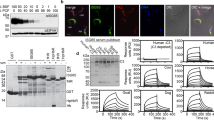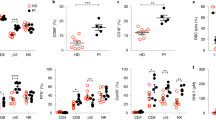Abstract
Live antibody-coatedTrypanosoma brucei parasites remove variable surface glycoprotein (VSG)-antibody complexes from their surface upon warming to 37° C and evade antibody-activated complement lysis by both protein synthesis-dependent and protein synthesis-independent mechanisms. The protein synthesis-dependent process follows antibody-mediated trypanosome agglutination, whereas the protein synthesis-independent mechanism can occur in the absence of trypanosome agglutination. The latter process leads to a more rapid climination of complement-fixing VSG-antibody complexes.
Similar content being viewed by others
References
Akol GWO, Murray M (1983)Trypanosoma congolense: susceptibility of cattle to cyclical challenge. Exp Parasitol 55:386–393
Allsopp BA, Njogu AR, Humphries KC (1971) Nature and localization ofTrypanosoma brucei subgroup exoantigen and its relation to 4S antigen. Exp Parasitol 29:271–284
Balber AE, Bangs JD, Jones SE, Proia RL (1979) Inactivation or elimination of potentially trypanolytic complement-activating immune complexes by pathogenic trypanosomes. Infect Immun 24:617–627
Baltz T, Baltz D, Giroud C, Crockett J (1985) Cultivation in a semi-defined medium of animal infective forms ofTrypanosoma brucei, T. equiperdum, T. evansi, T. rhodesiense andT. gambiense. EMBO J 4:1273–1279
Barry JD (1979) Capping of variant antigen onTrypanosoma brucei, and its immunological and biological significance. J Cell Sci 37:287–302
Barry JD, Emery DL (1984) Parasite development and host responses during the establishment ofTrypanosoma brucei infection transmitted by tsetse fly. Parasitology 88:67–84
Black SJ, Vandeweerd V (1989) Serum lipoproteins are required for multiplication ofTrypanosoma brucei brucei under axenic culture conditions. Mol Biochem Parasitol 37:65–72
Bülow R, Overath P, Davoust J (1988) Rapid lateral diffusion of the variant surface glycoprotein in the coat ofTrypanosoma brucei. Biochemistry 27:2384–2388
Bülow R, Nonnengasser C, Overath P (1989) Release of the variant surface glycoprotein during differentiation of bloodstream to procyclic forms ofTrypanosoma brucei. Mol Biochem Parasitol 32:85–92
Cross GAM (1975) Identification, purification and properties of clone-specific glycoprotein antigens constituting the surface coat ofTrypanosoma brucei. Parasitology 71:393–417
Cross GAM, Manning JC (1973) Cultivation ofTrypanosoma brucei spp. in semi-defined and defined media. Parasitology 67: 315–331
Crowe JS, Lamont AG, Barry JD, Vickerman K (1984) Cytotoxicity of monoclonal antibodies toTrypanosoma brucei. Trans R Soc Trop Med Hyg 78:508–513
Cunningham MP, Vickerman K (1962) Antigenic analysis in theTrypanosoma brucei group using the agglutination reaction. Trans R Soc Trop Med Hyg 56:48–59
Dempsey WA, Mansfield JM (1983) Lymphocyte function in experimental African trypanosomiasis. V. Role of antibody and the mononuclear phagocyte system in variant specific immunity. J Immunol 130:405–410
Emery DL, Akol GWO, Murray M, Morrison WI, Moloo SK (1980) The chancre-early events in the pathogenesis of African trypanosomiasis in domestic livestock In: Van der Bossche H (ed) The host invader interplay. Elsevier, Amsterdam pp. 345–356
Frevert U, Reinwald E (1988) Formation of filopodia inTrypanosoma congolense by cross-linking the variant surface antigen. Ultrastruct Mol Struct Res 99:124–136
Frevert U, Reinwald E (1990)Trypanosoma congolense bloodstream forms evade complement lysis in vitro by shedding of immune-complexes. Eur J Cell Biol 52:264–269
Grab DJ, Webster P, Ito S, Fish WR, Verjee Y, Lonsdale-Eccles JD (1987) Subcellular localization of a variable surface glycoprotein phosphatidylinositol-specific phospholipase-C in African trypanosomes. J Cell Biol 105:737–746
Gray AR (1961) Soluble antigens ofTrypanosoma vivax and other trypanosomes. Immunology 4:253–261
Gruenberg J, Howell KE (1989) Membrane traffic in endocytosis: insights from cell-free assays. Annu Rev Cell Biol 5:453–481
Hogan JC, Patton CL (1976) Variation in intramembrane components ofTrypanosoma brucei from intact and X-irradiated rats: a freeze-cleave study. J Protozool 23:205–215
Holmes PH, MacAskill JA, Whitelaw DD, Jennings FW, Urquhart GM (1979) Immunological clearance of 75Se-labelledTrypanosoma brucei in mice. I. Aspects of the radiolabelling technique. Immunology 36:415–420
Jadin JM, Lumsden WHR (1977) Etude en microscopie electronique desfilopodium-like processes des trypomastigotes sanguins deTrypanosoma brucei. Ann Soc Belge Med Trop 57: 459–463
Jenni L, Brun R (1980) In vitro cultivation of pleomorphicTrypanosoma brucei stocks: a possible source of variable antigens for immunization studies. Trans R Soc Trop Med Hyg 75:150–151
Lonsdale-Eccles JD, Grab DJ (1987) Purification of African trypanosomes can cause biochemical changes in the parasite. J Protozool 34:405–408
Luckins AG, Rae PF, Gray AR (1983) Infection, immunity and the development of local skin reactions in rabbits infected with cyclically transmitted stocks ofTrypanosoma congolense. Ann Trop Med Parasitol 77:569–582
Macadam RF, Herbert WJ (1970) Fine structural demonstration of cytoplasmic protrusion (filopodia) in trypanosomes. Exp Parasitol 27:1–8
MacAskill JA, Holmes PH, Whitelaw DD, McConnel JM, Jennings FW, Urquhart GM (1980) Immunological clearance of75Se-labelledTrypanosoma brucei in mice. II. Mechanism in immune mice. Immunology 40:629–635
Morrison WI, Black SJ, Paris J, Hinson CA, Wells PW (1982) Protective immunity and specificity of antibody responses elicited in cattle by irradiatedTrypanosoma brucei. Parasite Immunol 4:395–407
Naessens J, Newson J, Williams DJL, Lutje V (1988) Identification of isotypes and allotypes of bovine immunoglobulin M with monoclonal antibodies. Immunology 63:569–574
Nantulya VM, Doyle JJ (1977) Stabilization and preservation of the antigenic specificity ofTrypanosoma (Trypanozoon) brucei variant specific surface antigens by mild fixation techniques. Acta Trop (Basel) 34:313–320
Nantulya VM, Doyle JJ, Jenni L (1980) Studies onTrypanosoma (Nannomonas) congolense. IV. Experimental immunization of mice against tsetse fly challenge. Parasitology 80:133–137
Newson J, Mahan SM, Black SJ (1990) Synthesis and secretion of immunoglobulin by spleen cells from resistant and susceptible mice infected withTrypanosoma brucei brucei GUTat 3.1. Parasite Immunol 12:125–139
Oi VT, Herzenberg LA (1980) Immunoglobulin producing hybrid cell lines In: Mishell BB, Shugi SM (eds) Selected methods in cellular immunology. Freeman and Co., San Francisco, pp.351–372
Otieno-Omondi FP (1989) Regulation of the virulence of Trypanosoma brucei brucei S427 in mice. Thesis, Brunel University, London
Russo DCW (1992) Directional movement of VSG-antibody complexes in African trypanosomes. Thesis, Brunel University, London
Russo DCW, Grab DJ, Lonsdale-Eccles JD, Shaw MK, Williams DJL (1993) Directional movement of variable surface glycoprotein-antibody complexes inTrypanosoma brucei. Eur J Cell Biol 62:432–441
Seed JR, Bogucki M, Merrit S (1978) Interactions between immunoglobulins and the trypanosome cell surface. In: Cook CB, Pappas PW, Rudolph ED (eds) Cellular interaction in symbiosis and parasitism, Ohio State University Press, Columbus, Ohio, pp, 131–143
Sendashonga CN, Black SJ (1982) Humoral responses againstTrypanosoma brucei variable surface antigen are induced by degenerating parasites. Parasite Immunol 4:245–251
Seyfang A, Mecke D, Duszenko M (1990) Degradation, recycling and shedding ofTrypanosoma brucei variant surface glycoprotein. J Protozool 37:546–552
Turner CMR, Barry JD, Maudlin I, Vickerman K (1988) An estimate of the size of the metacyclic variable antigen repertoire ofTrypanosoma brucei rhodesiense. Parasitology 97:269–276
Vickerman K (1969) On the surface coat and flagellar adhesion in trypanosomes. J Cell Sci 5:163–193
Webster P, Grab DJ (1988) Intracellular colocalization of variant surface glycoprotein and transferrin-gold inTrypanosoma brucei. J Cell Biol 10:279–288
Webster P, Russo DCW, Black SJ (1990) The interaction ofTrypanosoma brucei with antibodies to variant surface glycoproteins. J Cell Sci 96:249–255
Wright KA, Lumsden WHR, Hales H (1970) The formation of filopodium-like processes byTrypanosoma (Trypanozoon) brucei. J Cell Sci 6:285–297
Author information
Authors and Affiliations
Rights and permissions
About this article
Cite this article
Russo, D.C.W., Williams, D.J.L. & Grab, D.J. Mechanisms for the elimination of potentially lytic complement-fixing variable surface glycoprotein antibody-complexes inTrypanosoma brucei . Parasitol Res 80, 487–492 (1994). https://doi.org/10.1007/BF00932695
Issue Date:
DOI: https://doi.org/10.1007/BF00932695




